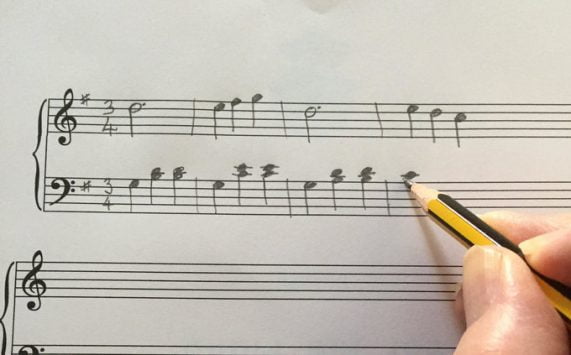Familiarity with piano chord progressions can help our students read more fluently, understand music theory better, and be able to get out of a performance glitch or memory slip in a hurry!
But building that solid knowledge takes time and repetition. And for repetition to stay fresh, we need some variety. So how can we make that repetition fun when we’re teaching piano chord progressions to our students?

There are tons of ways to practise chord progressions in lessons, but in this post I want to give you 5 great starting points. You can keep going with variations of these ideas for as long as you like, and then branch out once the creative juices start flowing.
Psst! Not sure what chord progression to use? Start with the old reliable I–V–vi–IV and go from there.
Chord Progression Activity 1: Accompany Scales
Playing along with your students’ scales using a simple vamp is a great way to make scales more musical and interesting to practice. Why not flip the script and have them accompany you?
- Teach your student a simple vamp, such as a I-V pattern.
- Get them to start and make sure they’re keeping a steady beat.
- Play a scale over the top (or, if you have 2 students together, get the other student to play a scale).
- Change keys and repeat!
This will teach your students the importance of keeping a steady beat and they’ll also be able to easily accompany anything or participate in a group session with this pattern.
Chord Progression Activity 2: Accompany Improv

You can use any piano chord progression at all for an improvisation. Start with a I–V–vi–IV, or get your student to invent their own.
- Decide on a chord progression together and get them to practice looping through it a few times.
- Come up with an ending for their pattern (a low tonic is an easy and effective option).
- Ask them to play the pattern several times while you improvise over it and do the ending when they feel like it.
- Swap roles and have them improvise while you play their chosen chord progression.
This is fun and creative and makes a great warmup or winddown routine for your lessons. Try out different patterns each week and your student will soon be a chord rockstar!
Chord Progression Activity 3: Rearrange a Piece
This idea for teaching piano chord progressions will require a little more theory knowledge, but it’s a fun experiment to try every so often.
- Take out a piece your student is playing that is heavily chord-based. (It can be broken chords or other patterns – just not contapuntal, imitative, etc.)
- Identify the chords and analyse how they fit together with the melody.
- Decide on chords to substitute in and rewrite the right and left hand to use the new chords.
- Have your student play the piece both ways and discuss the effect.
Rearranging a piece like this will take some time so you won’t want to do it in every lesson. It’s definitely a valuable experiment though and doing this every so often will broaden your student’s understanding of the impact of chords on the structure of music.
Chord Progression Activity 4: Learn a New Pattern
I’m all about preempting upcoming challenges my students will encounter by laying the groundwork for them now. Chord progressions are a great way to do this for left hand patterns.
- Look ahead to pieces your student will be learning in the coming months.
- Identify a left hand pattern (Alberti bass, broken chords, waltz, etc.) from one of these pieces which your student is not super comfortable with yet.
- Teach them this pattern by rote and apply it to a chord progression of their choice.
Yes, this takes a bit of planning on your part. But, gosh, it sure is worth it when they come to that piece and ace it in no time at all.

Chord Progression Activity 5: Create From Scratch
Teaching piano chord progressions can turn into a fantastic starting point for a student composition.
- Choose a key signature.
- Get your student to play all the chords in that key, going up the scale
- Ask them to choose a pattern of 3 – 5 chords and write the chord symbols above empty bars (measures) on a blank sheet of manuscript paper.
- Have them experiment with different left hand patterns using this chord progression and write in their favourite.
- Help them to add a right hand melody and expand the composition from there.
This is only one way to compose, of course, but I think it’s important to expose students to different methods of writing music so that they see it from all sides.
What’s your favourite piano chord progression?
What kinds of experiments and activities do you use in lessons with it? Share your ideas in the comments – the whackier the better!
And for more ideas on how to help students build a solid foundation in chords, visit my Music Theory page.
